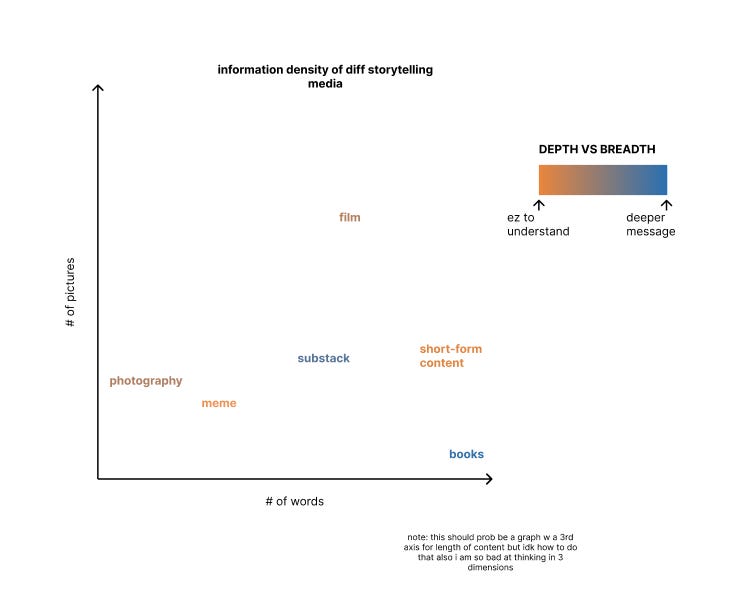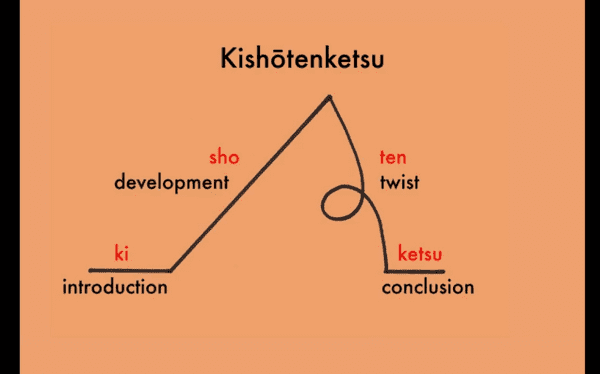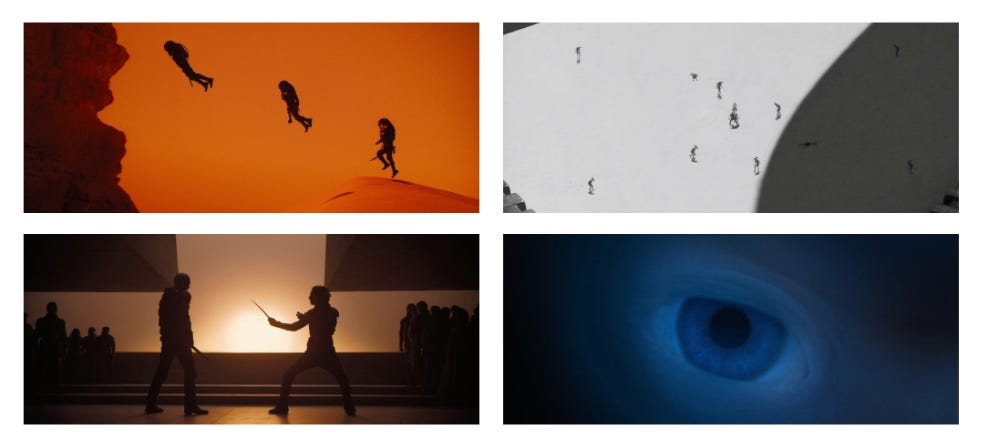full-stack storytelling
breaking it down into three lessons from three days
the past week, i’ve been thinking about stories while talking to friends, consuming media, and cooking up my own theories. beyond the pure content of a narrative, there are different elements to storytelling that i want to explore and experiment with.
thursday’s lesson: medium of storytelling
my trek to brooklyn is rewarded with a spacious living room and a cozy floor pillow to melt into. at my weekly poetry workshop I ponder how it fits into my other hobbies: notoriously abstract, dense, poetry has been an insular interest, as it usually takes several re-reads before any message reveals itself.
i’ve been playing with different media of storytelling — photography1, filmmaking, blogging, poetry — to observe how effective they are in a) capturing my message and b) communicating it to an audience. poetry seems truest to my inner feelings, yet it’s so hard to get the average person to understand. photography seems easy to disseminate to an audience, yet the actual message is left up to interpretation—there’s limited control in shaping it.
think about information density. aka — how precious is each word? in a poem, you only have <50 words on the page to work with, so everything, even an ampersand or a line break, bears greater weight. in a book, there are magnitudes more words, so you can get away with skimming through the pages. in magazines, you have pictures to aid your message. in film, you access another dimension to play with: time. the director has full control over how the audience consumes the story, in terms of how long they spend on each scene.
from the audience perspective, we have surrendered control. it’s easy to go on autopilot and let the scenes and sound wash over us, while still come away with some message; for a book, turning off our brain for just one page leaves us confused on what happened. i believe “working” for the content you consume allows for deeper insights — for example, reading a dense article versus watching a tik tok — but it makes the story less likely to be accessible to a general audience. there’s an inverse relationship between breadth & depth, how easy it is to understand a message and how deep it can be.

choose the medium that works best for your story — but learn how to combine and play with the different types, like leaning into poetry in screenwriting, or adding photos to substack articles.
friday’s lesson: the shape of a story
over $13 bowls of pho2, I ~ yapped & booled3 ~ w a friend making moves in the content space. they recommend the war of art4 and we talk about writing stories: me with substack, and them with short-form content, and how the skills are transferrable.
you might not be thinking about the rising action in a tik tok, but these literary elements make up any story. youtube vids begin in media res: in the heat of the moment, and the stakes keep rising until it ends on a high. speculative fiction follows the hero’s journey: some bilbo-baggins-figure is chosen to enter a new world, then there’s kishōtenketsu, led by murakami & miyazaki — subverting the western expectation for structure-based plot, it focuses on a gradual development & sudden twist to engage the viewer.
stories come in all shapes and sizes: they manifest as circles with parallel scenes, mountains with rising and falling action, even a sharks fin.
structure is great to give some predictability to audiences — especially on tik tok, when they’re not trying to think too hard--but then how do you reinvent the wheel?
everyone’s taken the same picture of central park. everyone’s seen a portrait with the person along the rule of thirds. so i use unique framing to make my photos stand out — people through gates, bridges, within mirrors. the same idea applies to writing — what frames do we use to package our story? how do we step within & outside of the frame? think epistolaries, flashbacks, vignettes. movies can take this one step further: arrival uses a non-linear format to mislead the audience; memento and tenet invert & reverse the timeline as a reflection of the core plot; life of pi is a movie within a movie.
the takeaway: start by studying the common structures of a story — and then experiment with bending the rules.
saturday’s lesson: colors in a story
there are some epics that make you think: god invented eyes so i could bear witness to this masterpiece. dune 2 was that for me. seeing it in theaters elicited a euphoria that hasn’t touched me in a while, not since reading Babel or Harry Potter. this is what the previous generation felt after watching star wars, i excitedly told my friend as we were walking out.5
amidst the insane fight scenes & sound design & dialogue, what really popped out was the color palette. my jaw dropped at the tension between the complementary orange setting sun & cool blue eyes. my bones melted at the desert shades of ochre, brown, and gold. my blood ran cold at the absence of color in harkonnen, how alien the bald psychopaths appeared in B&W.
color is the soul of a story. I am pushing sepia tones into my static photos via lightroom; researching archaic names for red to describe the fire in my poem; fighting with LUTs to color grade a video. in my video workflow, color-grading comes last, a reflection to its role in storytelling: first you choose the medium for all its constraints and strengths, then you shape the structure and shape of your story, and finally you breathe life and soul into your story with a splendid wash of paint. and because of the universality of color, i find stories everywhere. D2C brands use colors to symbolize something, interior designers use light brown and green plants to create vibes in a cafe, nature herself is overflowing with pink during cherry blossom season.
a story’s emotional valence is deeply intertwined with its colors. metaphorically speaking, color encompasses, atmosphere, emotional weight behind a story. think of synesthesia, which is the condition of crossing senses, seeing colors when you hear things, tasting shapes. the closest i’ll ever get to experiencing this phenomenon is through an amazing story — where my senses are overloaded with colors, shapes, sounds, they combine into a synthesis of profundity that’s greater than a sum its parts.
there’s been so much noise on how we augment the storytelling process with technology. i’m all for making tedious things faster, but the abstract hues of a story is one i feel is deeply human, and something i want to keep control over.
in order to thrive as a storyteller, learn how to use emotion to deliver a story that’s bursting with colors.
bring cash, saigon shack
is “yap & bool” a thing? im tryna make it a thing
turns out i have no original thoughts — found out another friend said the same thing afterwards





let's go saigon shack